Surface Energy Partitioning and Evaporative Fraction in a Water-Saving Irrigated Rice Field
Abstract
1. Introduction
2. Materials and Methods
2.1. Site Description and Field Management
2.2. Flux Data Measurement and Data Processing
2.3. Energy Balance Equation and Heat Storage Calculation
2.4. Evaluation of Energy Balance Closure
2.5. Evaporation Fraction and Enforcing Energy Balance Closure
3. Results and Discussion
3.1. Diurnal Variation of Energy Budget Components and Evaporative Fraction
3.2. Characteristics of Energy Budget Distribution during Each Growth Period
3.3. Seasonal Variation of Daily EF
4. Conclusions
Author Contributions
Funding
Acknowledgments
Conflicts of Interest
References
- Wever, L.A.; Flanagan, L.B.; Carlson, P.J. Seasonal and interannual variation in evapotranspiration, energy balance and surface conductance in a northern temperate grassland. Agric. For. Meteorol. 2002, 112, 31–49. [Google Scholar] [CrossRef]
- Wilson, K.; Goldstein, A.; Falge, E.; Aubinet, M.; Baldocchi, D.; Berbigier, P.; Bernhofer, C.; Ceulemans, R.; Dolman, H.; Field, C. Energy balance closure at FLUXNET sites. Agric. For. Meteorol. 2002, 113, 223–243. [Google Scholar] [CrossRef]
- Bormann, H. Sensitivity analysis of 18 different potential evapotranspiration models to observed climatic change at German climate stations. Clim. Chang. 2011, 104, 729–753. [Google Scholar] [CrossRef]
- Castellvi, F.; Snyder, R.L.; Baldocchi, D.D. Surface energy-balance closure over rangeland grass using the eddy covariance method and surface renewal analysis. Agric. For. Meteorol. 2008, 148, 1147–1160. [Google Scholar] [CrossRef]
- Hossen, M.S.; Mano, M.; Miyata, A.; Baten, M.A.; Hiyama, T. Surface energy partitioning and evapotranspiration over a double-cropping paddy field in bangladesh. Hydrol. Process. 2012, 26, 1311–1320. [Google Scholar] [CrossRef]
- Mauder, M.; Oncley, S.; Vogt, P.R.; Weidinger, T.; Ribeiro, L.; Bernhofer, C.; Foken, T.; Kohsiek, W.; de Bruin, H.A.R.; Liu, H. The energy balance experiment EBEX-2000. Part II: Intercomparison of eddy-covariance sensors and post-field data processing methods. Bound.-Layer Meteorol. 2007, 123, 29–54. [Google Scholar] [CrossRef]
- Leuning, R.; van Gorsel, E.; Massman, W.J.; Isaac, P.R. Reflections on the surface energy imbalance problem. Agric. For. Meteorol. 2012, 156, 65–74. [Google Scholar] [CrossRef]
- Kessomkiat, W.; Hendricks Franssen, H.J.; Graf, A.; Vereecken, H. Estimating random errors of eddy covariance data: An extended two-tower approach. Agric. For. Meteorol. 2013, 171–172, 203–219. [Google Scholar] [CrossRef]
- Gebler, S.; Hendricks Franssen, H.J.; Pütz, T.; Post, H.; Schmidt, M.; Vereecken, H. Actual evapotranspiration and precipitation measured by lysimeters: A comparison with eddy covariance and tipping bucket. Hydrol. Earth Syst. Sci. 2014, 19, 2145–2161. [Google Scholar] [CrossRef]
- Gao, Z.; Liu, H.; Katul, G.G.; Foken, T. Non-closure of the surface energy balance explained by phase difference between vertical velocity and scalars of large atmospheric eddies. Environ. Res. Lett. 2017, 12, 1–9. [Google Scholar] [CrossRef]
- Liu, X.; Yang, S.; Xu, J.; Zhang, J.; Liu, J. Effects of soil heat storage and phase shift correction on energy balance closure of paddy fields. Atmósfera 2017, 30, 39–52. [Google Scholar] [CrossRef]
- Brotzge, J.A.; Crawford, K.C. Estimation of the surface energy budget: A comparison of eddy correlation and Bowen ratio measurement systems. J. Hydrometeorol. 2003, 4, 160–177. [Google Scholar] [CrossRef]
- Foken, T.; Wimmer, F.; Mauder, M.; Thomas, C.; Liebethal, C. Some aspects of the energy balance closure problem. Atmos. Chem. Phys. 2006, 6, 4395–4402. [Google Scholar] [CrossRef]
- Foken, T. The energy balance closure problem: An overview. Ecol. Appl. 2008, 18, 1351–1367. [Google Scholar] [CrossRef] [PubMed]
- Billesbach, D.P. Estimating uncertainties in individual eddy covariance flux measurements: A comparison of methods and a proposed new method. Agric. For. Meteorol. 2011, 151, 394–405. [Google Scholar] [CrossRef]
- Foken, T.; Aubinet, M.; Finnigan, J.J.; Leclerc, M.Y.; Mauder, M.; Tha, P.U.K. Results of a panel discussion about the energy balance closure correction for trace gases. Bull. Am. Meteorol. Soc. 2011, 92, 13–18. [Google Scholar] [CrossRef]
- Gao, Z.; Russell, E.S.; Missik, J.E.C.; Huang, M.; Chen, X.; Strickland, C.E.; Clayton, R.; Arntzen, E.; Ma, Y.; Liu, H. A novel approach to evaluate soil heat flux calculation: An analytical review of nine methods. J. Geophys. Res.-Atmos. 2017, 122, 6934–6949. [Google Scholar] [CrossRef]
- Gao, Z.; Liu, H.; Russell, E.S.; Huang, J.; Foken, T.; Oncley, S.P. Large eddies modulating flux convergence and divergence in a disturbed unstable atmospheric surface layer. J. Geophys. Res.-Atmos. 2016, 121, 1475–1492. [Google Scholar] [CrossRef]
- Farah, H.O.; Bastiaanssen, W.G.M.; Feddes, R.A. Evaluation of the temporal variability of the evaporative fraction in a tropical watershed. Int. J. Appl. Earth Obs. 2004, 5, 129–140. [Google Scholar] [CrossRef]
- Suleiman, A.; Crago, R. Hourly and Daytime Evapotranspiration from Grassland Using Radiometric Surface Temperatures. Agron. J. 2004, 96, 384–390. [Google Scholar] [CrossRef]
- Nutini, F.; Boschetti, M.; Candiani, G.; Bocchi, S.; Brivio, P.A. Evaporative fraction as an indicator of moisture condition and water stress status in semi-arid rangeland ecosystems. Remote Sens. 2014, 6, 6300–6323. [Google Scholar] [CrossRef]
- Lu, J.; Tang, R.; Shao, K.; Li, Z.L.; Zhou, G. Assessment of two temporal-information-based methods for estimating evaporative fraction over the southern great plains. Int. J. Remote Sens. 2015, 36, 4936–4952. [Google Scholar] [CrossRef]
- Kustas, W.; Schmugge, T.; Humes, K.; Jackson, T.; Parry, R.; Weltz, M.; Moran, M. Relationships between evaporative fraction and remotely sensed vegetation index and microwave brightness temperature for semiarid rangelands. J. Appl. Metereol. 1993, 32, 1781–1790. [Google Scholar] [CrossRef]
- Kurc, S.A.; Small, E.E. Dynamics of evapotranspiration in semiarid grassland and shrubland ecosystems during the summer monsoon season, central New Mexico. Water Resour. Res. 2004, 40, W09305. [Google Scholar] [CrossRef]
- Guyot, A.; Cohard, J.M.; Anquetin, S.; Galle, S. Long-term observations of turbulent fluxes over heterogeneous vegetation using scintillometry and additional observations: A contribution to AMMA under Sudano-Sahelian climate. Agric. For. Meteorol. 2012, 154–155, 84–98. [Google Scholar] [CrossRef]
- Higuchi, A.; Kondoh, A.; Kishi, S. Relationship among the surface albedo, spectral reflectance of canopy, and evaporative fraction at grassland and paddy field. Adv. Space Res. 2000, 26, 1043–1046. [Google Scholar] [CrossRef]
- Shuttleworth, W.J.; Gurney, R.J.; Hsu, A.Y.; Ormsby, J.P. FIFE: The variation in energy partition at surface flux sites. IAHS Publ. 1989, 186, 67–74. [Google Scholar]
- Li, S.E.; Kang, S.Z.; Li, F.S.; Zhang, L.; Zhang, B.Z. Vineyard evaporative fraction based on eddy covariance in an arid desert region of Northwest China. Agric. Water Manag. 2008, 95, 937–948. [Google Scholar] [CrossRef]
- Santos, C.A.C.D.; Silva, B.B.D.; Rao, T.V.R. Analysis of the evaporative fraction using eddy covariance and remote sensing techniques. Revista Brasileira De Meteorologia 2010, 25, 427–436. [Google Scholar] [CrossRef]
- Zhang, Y.Q.; Shen, Y.J.; Liu, C.M.; Yu, Q.; Sun, H.W.; Jia, J.S.; Tan, C.Y.; Kondoh, A. Measurement and analysis of water, heat and CO2 flux from a farmland in the North China Plain. Acta Geographic Sinica 2002, 57, 333–342, (In Chinese, with English Abstract). [Google Scholar]
- Uchijima, Z. On characteristics of heat balance of water layer under paddy plant cover. Bull. Natl. Inst. Agric. Sci. 1961, A8, 243–265. [Google Scholar]
- Hayashi, K. Efficiencies of solar energy conversion in rice varieties. Jpn. J. Crop Sci. 1966, 35, 205–211. [Google Scholar] [CrossRef]
- Harazono, Y.; Kim, J.; Miyata, A.; Choi, J.T.; Yun, I.; Kim, J.W. Measurement of energy budget components during the International Rice Experiment (IREX) in Japan. Hydrol. Process. 1998, 12, 2081–2092. [Google Scholar] [CrossRef]
- Tsai, J.L.; Tsuang, B.J.; Lu, P.S.; Yao, M.H.; Shen, Y. Surface energy components and land characteristics of a rice paddy. J. Appl. Meteorol. Clim. 2007, 46, 1879–1900. [Google Scholar] [CrossRef]
- Kar, G.; Kumar, A. Radiation utilization efficiency and evaporative fraction of rainfed rice in eastern India. J. Agrometeorol. 2016, 18, 184–189. [Google Scholar]
- Timm, A.U.; Roberti, D.R.; Streck, N.A.; Luis, G.G.D.G.; Acevedo, O.C.; Moraes, O.L.L.; Moreira, V.S.; Degrazia, G.A.; Ferlan, M.; Toll, D.L. Energy partitioning and evapotranspiration over a rice paddy in southern brazil. J. Hydrometeorol. 2014, 15, 1975–1988. [Google Scholar] [CrossRef]
- Masseroni, D.; Facchi, A.; Romani, M.; Chiaradia, E.A.; Gharsallah, O.; Gandolfi, C. Surface energy flux measurements in a flooded and an aerobic rice field using a single eddy-covariance system. Paddy Water Environ. 2015, 13, 405–424. [Google Scholar] [CrossRef]
- Sobrino, J.A.; Gómez, M.; Jiménez-Muñoz, J.C.; Olioso, A. Application of a simple algorithm to estimate daily evapotranspiration from NOAA-VHRR images for the Iberian Peninsula. Remote Sens. Environ. 2007, 110, 139–148. [Google Scholar] [CrossRef]
- Hoedjes, J.C.B.; Chehbouni, A.; Jacob, F.; Ezzahar, J.; Boulet, G. Deriving daily evapotranspiration from remotely sensed instantaneous evaporative fraction over olive orchard in semi-arid morocco. J. Hydrol. 2008, 354, 53–64. [Google Scholar] [CrossRef]
- Sun, Z.; Gebremichael, M.; Ardö, J.; Nickless, A.; Caquet, B.; Merboldh, L.; Kutschi, W. Estimation of daily evapotranspiration over Africa using MODIS/Terra and SEVIRI/MSG data. Atmos. Res. 2012, 112, 35–44. [Google Scholar] [CrossRef]
- Ding, Y.M.; Wang, W.G.; Song, R.M.; Shao, G.X.; Jiao, X.Y.; Xing, W.Q.; Wang, W. Modeling spatial and temporal variability of the impact of climate change on rice irrigation water requirements in the middle and lower reaches of the Yangtze River, China. Agric. Water Manag. 2017, 193, 89–101. [Google Scholar] [CrossRef]
- China Water Resources Bulletin 2016. Available online: http://www.mwr.gov.cn/sj/tjgb/szygb/201707/t20170711_955305.html (accessed on 17 September 2018).
- Gao, Z.; Bian, L.; Zhou, X. Measurements of turbulent transfer in the near surface layer over a rice paddy in China. J. Geophys. Res. 2003. [Google Scholar] [CrossRef]
- Castellvi, F.; Martínez-Cob, A.; Pérez-Coveta, O. Estimating sensible and latent heat fluxes over rice using surface renewal. Agric. For. Meteorol. 2006, 139, 164–169. [Google Scholar] [CrossRef]
- Linquist, B.; Snyder, R.; Anderson, F.; Espino, L.; Inglese, G.; Marras, S.; Moratiel, R.; Mutters, R.; Nicolosi, P.; Rejmanek, H.; et al. Water balances and evapotranspiration in water-and dry-seeded rice systems. Irrig. Sci. 2015, 33, 375–385. [Google Scholar] [CrossRef]
- Xu, J.; Peng, S.; Yang, S.; Wang, W. Ammonia volatilization losses from a rice paddy with different irrigation and nitrogen managements. Agric. Water Manag. 2012, 104, 184–192. [Google Scholar] [CrossRef]
- Anthoni, P.M.; Freibauer, A.; Kolle, O.; Schulz, E.-D. Winter wheat carbon exchange in Thuringia, Germany. Agric. For. Meteorol. 2004, 121, 55–67. [Google Scholar] [CrossRef]
- Mauder, M.; Liebethal, C.; Göckede, M.; Leps, J.P.; Beyrich, F.; Foken, T. Processing and quality control of flux data during LITFASS-2003. Bound.-Layer Meteorol. 2006, 121, 67–88. [Google Scholar] [CrossRef]
- Ueyama, M.; Hirata, R.; Mano, M.; Hamotani, K.; Harazono, Y.; Hirano, T.; Miyata, A.; Takagi, K.; Takahashi, Y. Influences of various calculation options on heat, water and carbon fluxes determined by open- and closed- path eddy covariance methods. Tellus B 2012, 64, 1–26. [Google Scholar] [CrossRef]
- Masseroni, D.; Ercolani, G.; Corbari, C.; Mancini, M. Accuracy of turbulent flux measurements through the use of high frequency data by eddy covariance tower: The case study of Landriano (PV) Italy. Ital. J. Agrometeorol. 2013, 3, 5–12. [Google Scholar]
- Mauder, M.; Cuntz, M.; Drue, C.; Graf, A.; Rebmann, C.; Schmid, H.P.; Schmidt, M.; Steinbrecher, R. A strategy for quality and uncertainty assessment of long-term eddy-covariance measurements. Agric. For. Meteorol. 2013, 169, 122–135. [Google Scholar] [CrossRef]
- Kljun, N.; Calanca, P.; Rotach, M.P.; Schmid, H.P. A simple parameterisation for flux footprint predictions. Bound.-Layer Meteorol. 2004, 112, 503–523. [Google Scholar] [CrossRef]
- Aubinet, M.; Vesala, T.; Papale, D. Eddy Covariance: A Practical Guide to Measurement and Data Analysis; Springer: Berlin/Heidelberg, Germany, 2012; pp. 365–376. [Google Scholar]
- Masseroni, D.; Ravazzani, G.; Corbari, C.; Mancini, M. Turbulence integral length and footprint dimension with reference to experimental data measured over maize cultivation in Po Valley, Italy. Atmosfera 2012, 25, 183–198. [Google Scholar]
- Falge, E.; Baldocchi, D.; Olson, R.; Anthoni, P.; Aubinet, M.; Bernhofer, C.; Burba, G.; Ceulemans, R.; Clement, R.; Dolman, H. Gap filling strategies for long term energy flux data sets. Agric. For. Meteorol. 2001, 107, 71–77. [Google Scholar] [CrossRef]
- Russell, E.S.; Liu, H.; Gao, Z.; Finn, D.; Lamb, B. Impacts of soil heat flux calculation methods on the surface energy balance closure. Agric. For. Meteorol. 2015, 214–215, 189–200. [Google Scholar] [CrossRef]
- Meyers, T.; Hollinger, S. An assessment of storage terms in the surface energy balance of maize soybean. Agric. For. Meteorol. 2004, 125, 105–115. [Google Scholar] [CrossRef]
- Heitman, J.L.; Horton, R.; Sauer, T.J.; Ren, T.S.; Xiao, X. Latent heat in soil heat flux measurements. Agric. For. Meteorol. 2010, 150, 1147–1153. [Google Scholar] [CrossRef]
- Lee, X. On micrometeorological observations of surface-air exchange over tall vegetation. Agric. For. Meteorol. 1998, 91, 39–49. [Google Scholar] [CrossRef]
- Zhang, Y.; Liu, H.; Foken, T.; Williams, Q.L.; Liu, S.; Mauder, M.; Liebethal, C. Turbulence spectra and cospectra under the influence of large eddies in the energy balance experiment (EBEX). Bound.-Layer Meteorol. 2010, 136, 235–251. [Google Scholar] [CrossRef]
- Zhou, Y.Z.; Li, D.; Liu, H.P.; Li, X. Diurnal variations of the flux imbalance over homogeneous and heterogeneous landscapes. Bound.-Layer Meteorol. 2018, 168, 417–442. [Google Scholar] [CrossRef]
- Foken, T.; Goockede, M.; Mauder, M.; Mahrt, L.; Amiro, B.; Munger, W. Post-Field Data Quality Control; Springer: Dordrecht, The Netherlands, 2006; pp. 181–208. [Google Scholar]
- Frank, J.M.; Massman, W.J.; Ewers, B.E. Underestimates of sensible heat flux due to vertical velocity measurement errors in non-orthogonal sonic anemometers. Agric. For. Meteorol. 2013, 171, 72–81. [Google Scholar] [CrossRef]
- Sugita, M.; Brutsaert, W. Daily evaporation over a region from lower boundary layer profiles measured with radiosondes. Water Resour. Res. 1991, 27, 747–752. [Google Scholar] [CrossRef]
- Vickers, D.; Gockede, M.; Law, B.E. Uncertainty estimates for 1-h averaged turbulence fluxes of carbon dioxide, latent heat and sensible heat. Tellus Ser. B Chem. Phys. Meteorol. 2010, 62, 87–99. [Google Scholar] [CrossRef]
- Ding, R.S.; Kang, S.Z.; Zhang, Y.Q. Evaluating eddy covariance method in evapotranspiration measurements by large—Scale weight lysimeter. In Proceedings of the 6th Academic Seminar of National Agricultural and Soil Engineering, Kun Ming, China, 6–8 August 2010; pp. 225–233, (In Chinese, with English Abstract). [Google Scholar]
- Chen, H.; Yang, D.W.; Lv, H.F. Comparison of temporal extrapolation methods for evapotranspiration over variant underlying croplands. Trans. Chin. Soc. Agric. Eng. 2013, 29, 73–81, (In Chinese, with English Abstract). [Google Scholar]
- Ham, J.M.; Heilman, J.L.; Lascano, R.J. Soil and canopy energy balances of a row crop at partial cover. Agron. J. 1991, 83, 744–753. [Google Scholar] [CrossRef]
- Suyker, A.E.; Verma, S.B. Interannual water vapor and energy exchange in an irrigated maize-based agroecosystem. Agric. For. Meteorol. 2008, 148, 417–427. [Google Scholar] [CrossRef]
- Jia, Z.J.; Zhang, W.; Huang, Y. Analysis of energy flux in rice paddy in the sanjiang plain. Chin. J. Eco-Agric. 2010, 18, 820–826, (In Chinese, with English Abstract). [Google Scholar] [CrossRef]
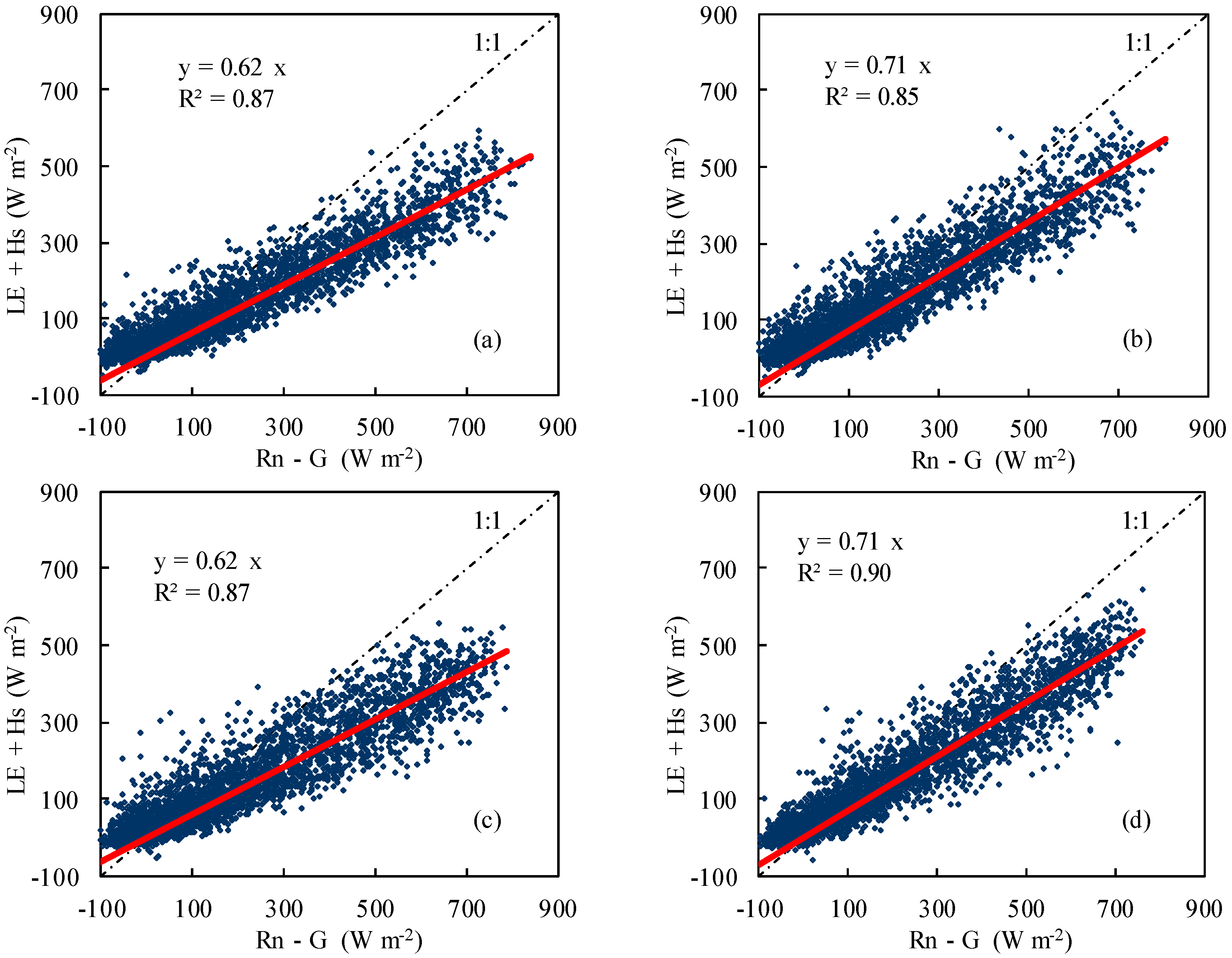
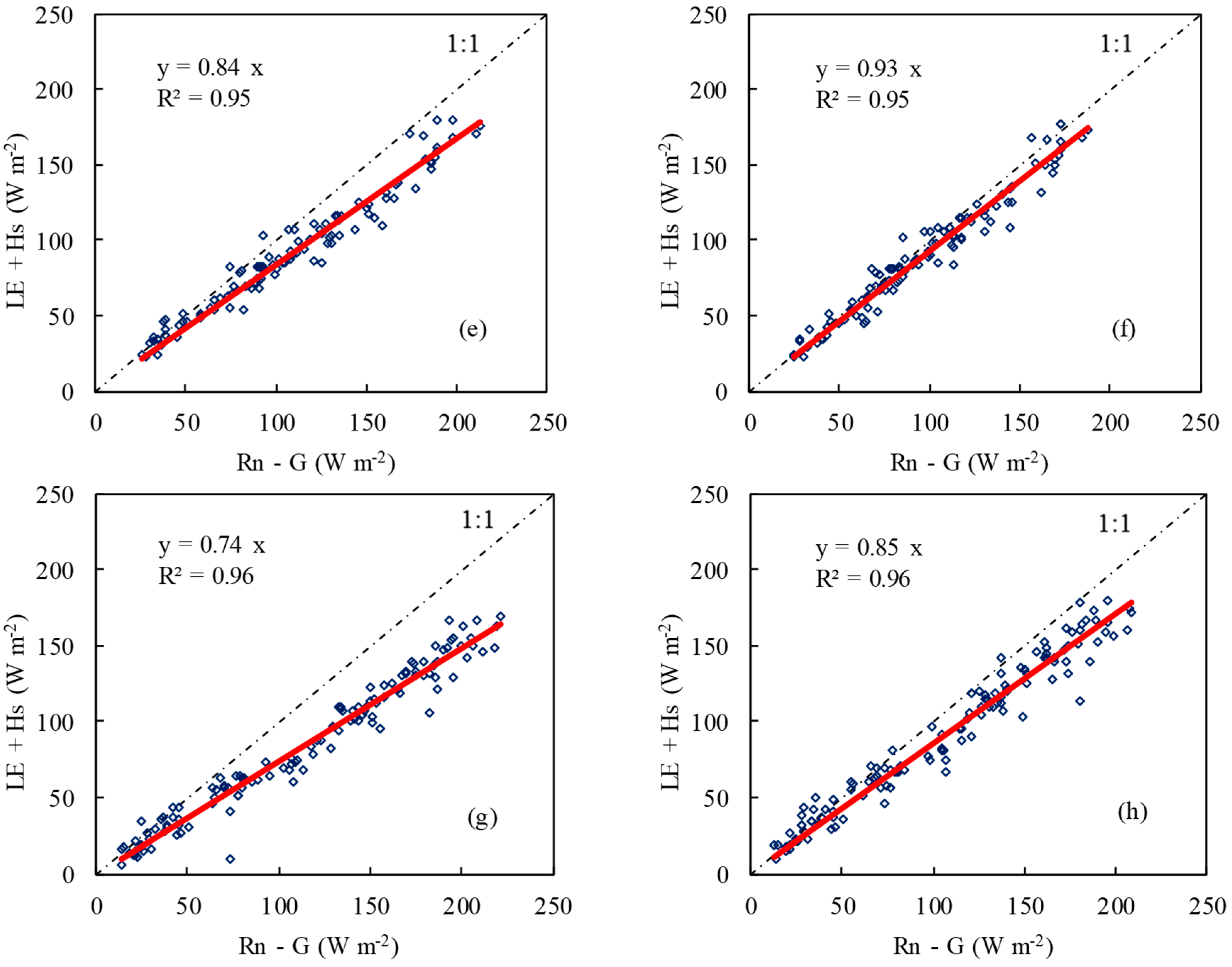
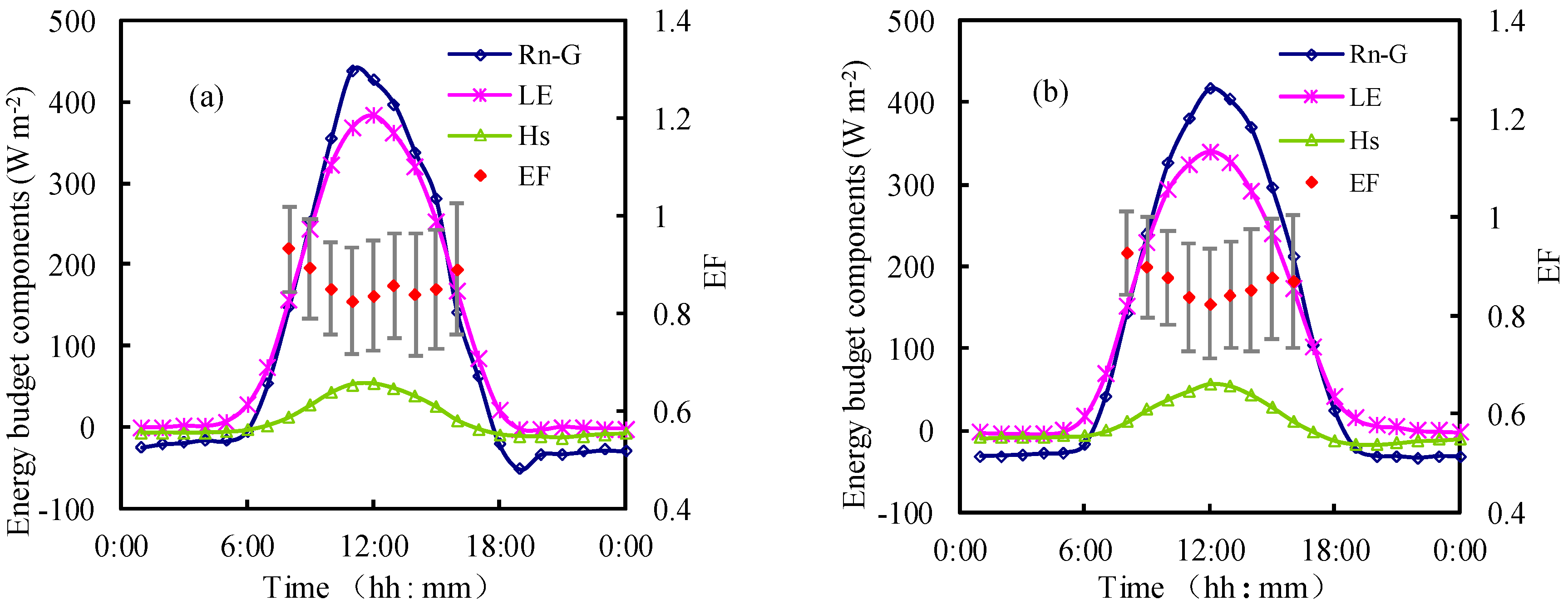
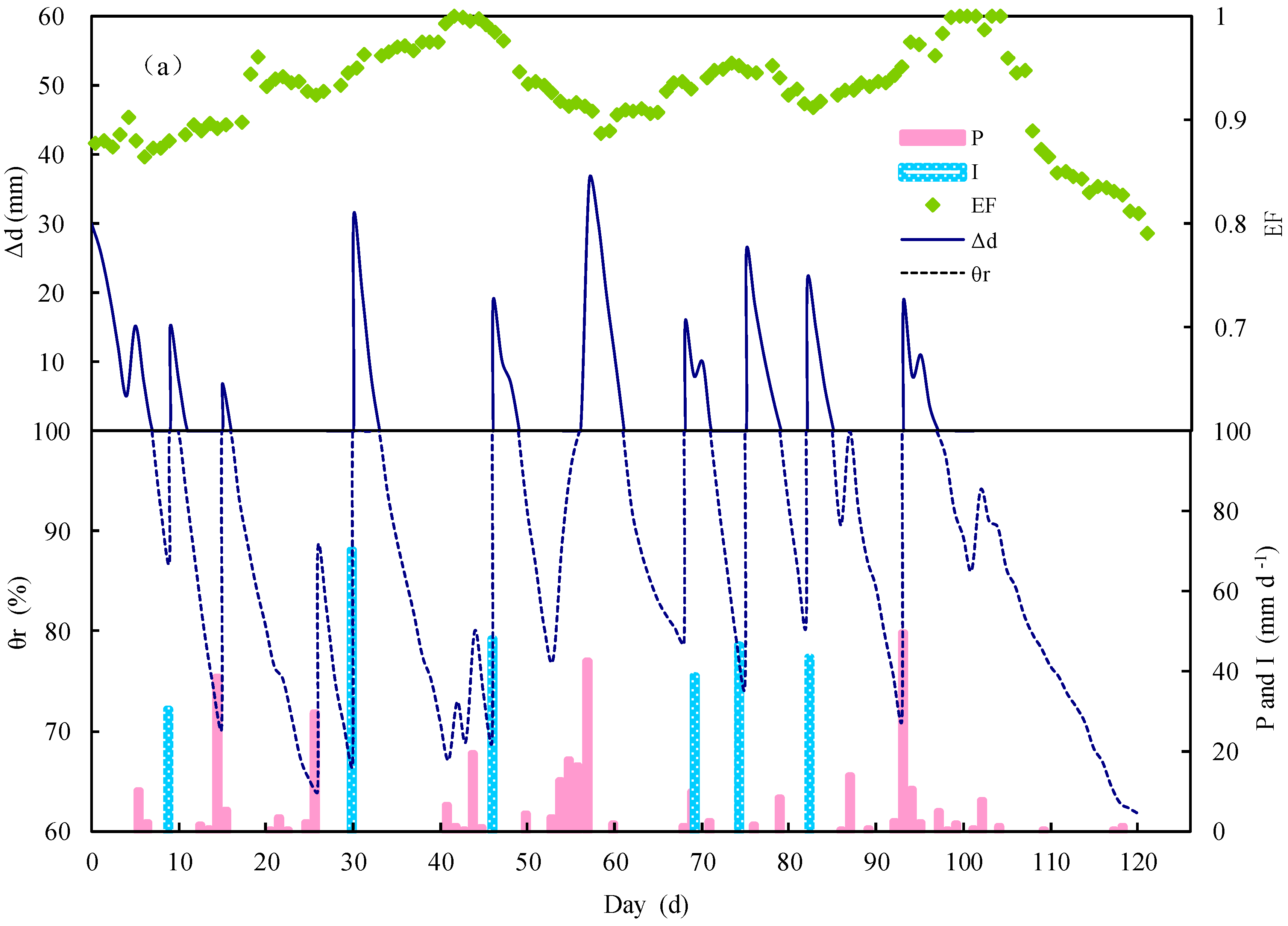
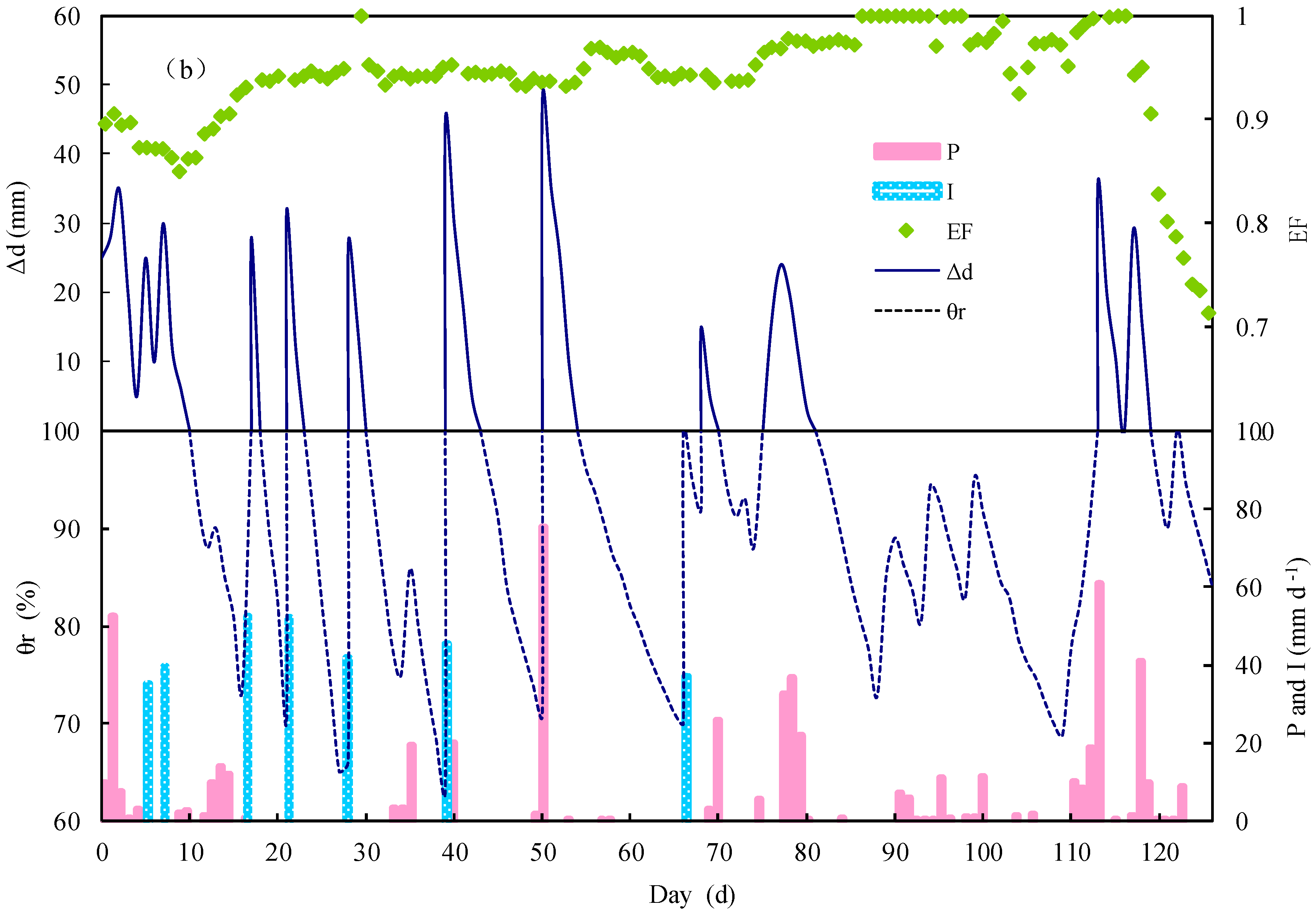
| Year | Growth Stages | Period | Days | Partition Ratio | ||
|---|---|---|---|---|---|---|
| LE/Rn | Hs/Rn | G/Rn | ||||
| 2015 | Re-greening | 6.27–7.4 | 8 | 0.810 | 0.077 | 0.113 |
| Early tillering | 7.5–7.13 | 9 | 0.807 | 0.096 | 0.097 | |
| Middle tillering | 7.14–7.28 | 15 | 0.870 | 0.055 | 0.075 | |
| Later tillering | 7.29–8.7 | 10 | 0.965 | 0.020 | 0.015 | |
| Jointing and booting | 8.8–9.4 | 28 | 0.895 | 0.066 | 0.039 | |
| Heading to flowering | 9.5–9.12 | 8 | 0.908 | 0.050 | 0.042 | |
| Milk | 9.13–10.14 | 32 | 0.917 | 0.054 | 0.029 | |
| Yellow ripening | 10.15–10.25 | 11 | 0.823 | 0.166 | 0.011 | |
| Whole growth stage | 6.27–10.25 | 121 | 0.882 | 0.059 | 0.058 | |
| 2016 | Re-greening | 7.2–7.9 | 8 | 0.790 | 0.104 | 0.106 |
| Early tillering | 7.10–7.19 | 10 | 0.818 | 0.096 | 0.086 | |
| Middle tillering | 7.20–8.2 | 14 | 0.866 | 0.050 | 0.084 | |
| Later tillering | 8.3–8.12 | 10 | 0.871 | 0.052 | 0.077 | |
| Jointing and booting | 8.13–9.9 | 28 | 0.881 | 0.050 | 0.069 | |
| Heading to flowering | 9.10–9.19 | 10 | 0.916 | 0.032 | 0.052 | |
| Milk | 9.20–10.19 | 30 | 0.966 | 0.019 | 0.015 | |
| Yellow ripening | 10.20–11.3 | 15 | 0.815 | 0.096 | 0.089 | |
| Whole growth stage | 7.1–11.3 | 125 | 0.898 | 0.058 | 0.044 | |
© 2019 by the authors. Licensee MDPI, Basel, Switzerland. This article is an open access article distributed under the terms and conditions of the Creative Commons Attribution (CC BY) license (http://creativecommons.org/licenses/by/4.0/).
Share and Cite
Liu, X.; Xu, J.; Yang, S.; Lv, Y. Surface Energy Partitioning and Evaporative Fraction in a Water-Saving Irrigated Rice Field. Atmosphere 2019, 10, 51. https://doi.org/10.3390/atmos10020051
Liu X, Xu J, Yang S, Lv Y. Surface Energy Partitioning and Evaporative Fraction in a Water-Saving Irrigated Rice Field. Atmosphere. 2019; 10(2):51. https://doi.org/10.3390/atmos10020051
Chicago/Turabian StyleLiu, Xiaoyin, Junzeng Xu, Shihong Yang, and Yuping Lv. 2019. "Surface Energy Partitioning and Evaporative Fraction in a Water-Saving Irrigated Rice Field" Atmosphere 10, no. 2: 51. https://doi.org/10.3390/atmos10020051
APA StyleLiu, X., Xu, J., Yang, S., & Lv, Y. (2019). Surface Energy Partitioning and Evaporative Fraction in a Water-Saving Irrigated Rice Field. Atmosphere, 10(2), 51. https://doi.org/10.3390/atmos10020051








